My love affair with Monarch butterflies began in earnest in 2005. My friend Jenny Singleton had introduced us the year before. But the following October, on a warm Saturday afternoon, I stepped from my kayak in the Llano River and approached a stand of pecan trees bowed to the ground in submission from serial floods. My red rubber boots stuck for a moment in the mud, but when I looked up, I was struck. A silent eruption of Monarch butterflies wafted from the earth. Hundreds of them drifted skyward–floating, flitting, and fleeting before settling on bare tree limbs.
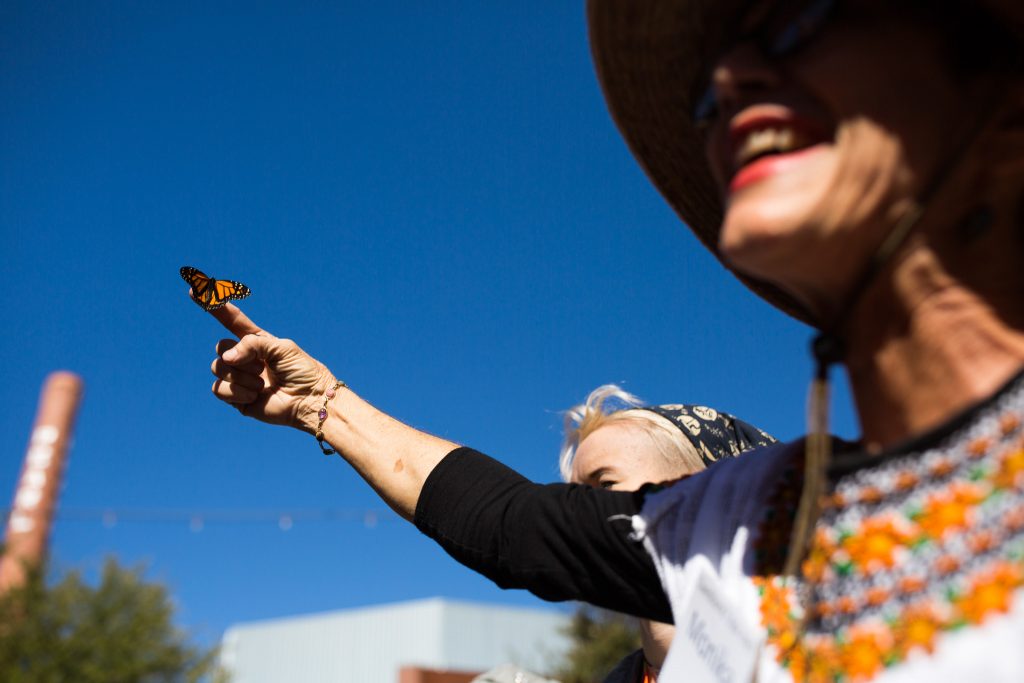
Yes, I’m smitten–how can you not be? That’s me at the 2016 Monarch Butterfly and Pollinator Festival at the Pearl. Photo by Scott Ball
That was the day—the day I call my Magical Monarch Saturday–I fell profoundly, entirely in love with these insects. I’ve been reading and writing about them ever since, as well as raising them at home.
I’m not alone. Tens of thousands of people are smitten with Denaus plexipus. The species even has its own listserv, the DPLEX, with more than 800 subscribers.
Hundreds of websites and social media pages are devoted to Monarchs and their conservation, some of which flaunt tens of thousands of fans–Monarch Watch on Facebook with 38K+ followers, for example. Festivals celebrate Monarch butterflies in spring, summer and fall in Canada, the U.S. and Mexico. The Monarch serves as the official insect of seven states in the U.S. A 2013 survey published in Conservation Letters indicated U.S. households are willing to spend $4.78–$6.64 billion–yes, BILLION– for Monarch conservation through direct contributions and the purchase of milkweed and appropriate nectar plants. Monarchs are among the most studied insects in the world, with multi-millions of dollars devoted to researching their life cycle, habitat and diseases/threats. Tens of thousands of Monarchs are also bred commercially and by hobbyists each year for use in classrooms and educational events to teach metamorphosis. Some folks even tap the Monarch to commemorate special occasions like weddings, funerals and life changes.
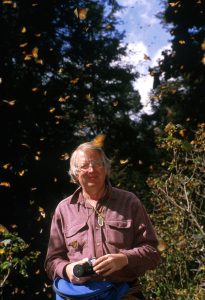
Monarch butterfly expert Dr. Lincoln Brower with overwintering monarch butterflies. Rosario overwintering colony, 4-6 February 1991. (Photo by Perry Conway.)
“I think of them as magical bottles of wine. You can pour it all out and when you go back, it’s full again. There is no end to the questions you can ask.” That’s how Dr. Lincoln Brower, who has studied Monarchs for more than five decades, summed up the Monarch’s charms in the 2004 book Four Wings and A Prayer.
So why do we love Monarch butterflies so much? Lots of reasons.
First, they don’t sting or bite. Their bold, orange-and-black, stained-glass wings make them stand out and ward off predators. A dreamy flight pattern suggests confidence. Their elusive flits and turns connote flirtatiousness. Turning legs into wings—now that’s magical. And navigating thousands of miles “home” to a sacred forest never seen demonstrates tenacity and strength. It commands our admiration. Monarchs’ back story is also loaded with intrigue—scientific rivalries, mysterious chemical powers, a strong codependence on members of the milkweed family. All this makes for an incessantly interesting long-term relationship.
For Valentine’s Day in this year of such dramatic political change and on the heels of news that their numbers are down by almost a third, we thought it appropriate to ask Monarch butterfly lovers to articulate their feelings for the Americas’ most beloved insect. Their loving quotes follow, but perhaps more telling are the looks of pure joy on their faces in the photos they shared.
Nola Garcia of San Antonio, age 9, recalled receiving a gift of caterpillars on milkweed. She’s been raising and tagging Monarchs ever since.
“I remember the excitement of finding them all over my room when it was time for them to become chrysalises,” said Nola. “I saw one split its skin and pulsing as it changed. I love seeing them right after they come out when their wings unfold. My favorite part is letting them go and watching them fly off. I love how they look.”

Nola Garcia enjoys a freshly hatched male Monarch butterfly in her kitchen before releasing him to the wind. Photo by Tracy Idell Hamilton
Dara Satterfield of Georgia studies Monarch butterflies as a James Smithson Fellow at the Smithsonian Conservation Biology Institute. She sees a transformation myth in Monarch butterfly biology. “Monarchs grow up, reinvent themselves (in the chrysalis), and undertake a long journey that is all-at-once beautiful and treacherous and difficult,” said Satterfield, who has studied with Dr. Sonia Altizer, the foremost expert on the Monarch centric spore-driven disease, OE. “This story seems familiar, even personal, to us. It’s much like the human experience, in miniature. So we root for Monarchs. We want to see them thrive.”
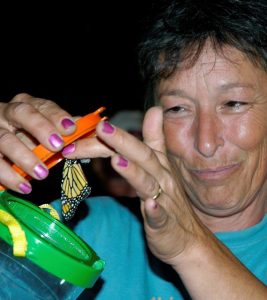
Cathy Downs, Monarch Watch Conservation Specialist, welcomes a freshly hatched Monarch into the world. Courtesy photo
“As a child, I loved Monarchs because they were at times amusing, cartoonish and full of wonder and discovery,” explained Cathy Downs, Monarch Watch Conservation Outreach Specialist in Central and South Texas. “During career years, the sight of a Monarch took me back with a sigh, if only for a moment in a busy life, to my childhood. In retirement, Monarchs have opened thousands of doors for me to new people, new places and new passions.”
Drake White, founder of the Nectar Bar, a Facebook page devoted to educating people how to raise butterflies at home has a special greeting when she welcomes someone or signs off from her page: “Peace, love and butterflies.” White manages the butterfly house at Phil Hardberger Park in San Antonio and does pollinator landscape consulting on the side. She loves all butterflies, but admits Monarchs are her favorite. Their metamorphosis “always makes me understand just how amazing nature truly is,” she said. “I never want to lose that. It keeps me bonding with nature.”

Drake White of the Nectar Bar’s signature butterfly greeting is Peace, Love and Butterflies. Photo by Drake White
Hope, beauty and perseverance are consistent themes among Monarch butterfly lovers. Jeanette LaVesque, who follows Monarchs from Minneapolis, said the butterflies “give me hope for a beautiful transformation for myself someday–either here or beyond. They prove to me that miracles happen in this world….Butterlies make my garden feel like a little paradise when they are present.”
Dr. Karen Oberhauser of the University of Minnesota and founder of the Monarch Larvae Monitoring Project, has been studying Monarch butterflies and working to bring them to children and classrooms since 1984. And yet, ”I’ll never tire of bringing the eggs and larvae into my house and watching them undergo their amazing metamorphosis, or walking into my lab full of students helping to unravel monarch mysteries,” she said, adding that Monarchs are beautiful, familiar, interesting, and impressive. “They evoke deep connections between people and nature,” said Oberhauser.
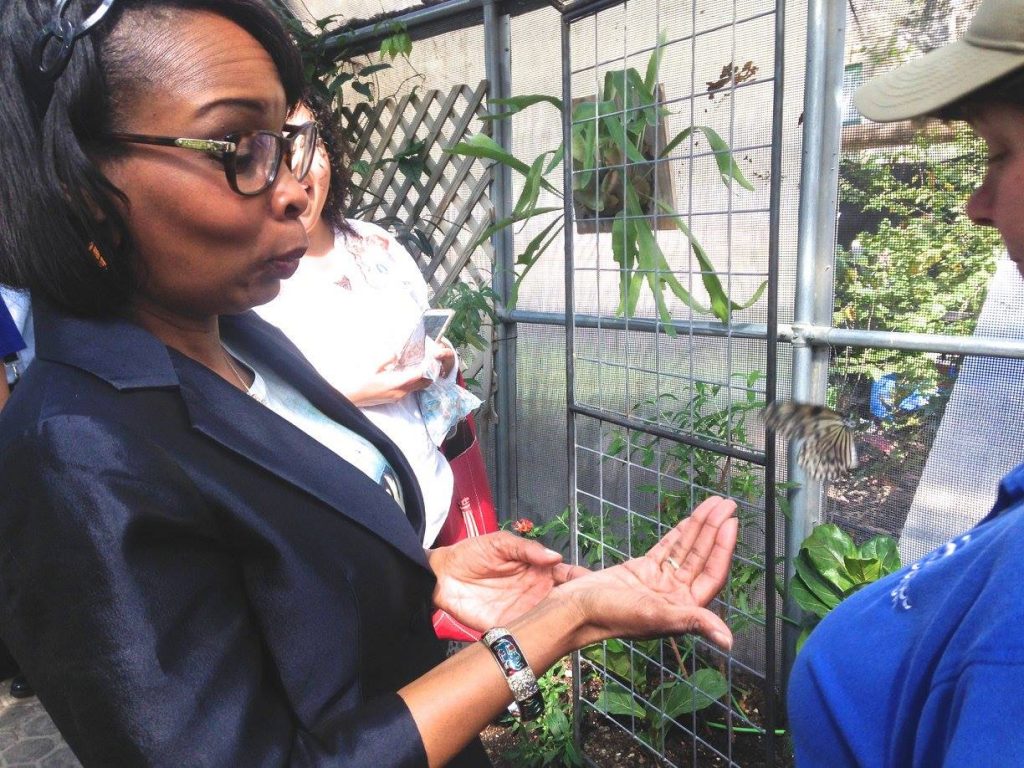
Mayor Taylor wears Monarch butterfly wing bling earrings and releases another type of butterfly at the San Antonio Zoo Monarch Festival in 2016. Photo by Monika Maeckle
San Antonio Mayor Ivy Taylor became the first in the country to sign the National Wildlife Federation’s Mayor’s Monarch pledge in 2015. Taylor, who grew up in Queens, New York, was completely unfamilar with the Monarch migration until shortly before signing the pledge. But once she and Monarchs got acquainted, it was a pretty quick romance. “The story of the Monarch’s migration is what really caught my attention,” she said. “It’s amazing that such a fragile creature has the perseverance to travel thousands of miles every year.”
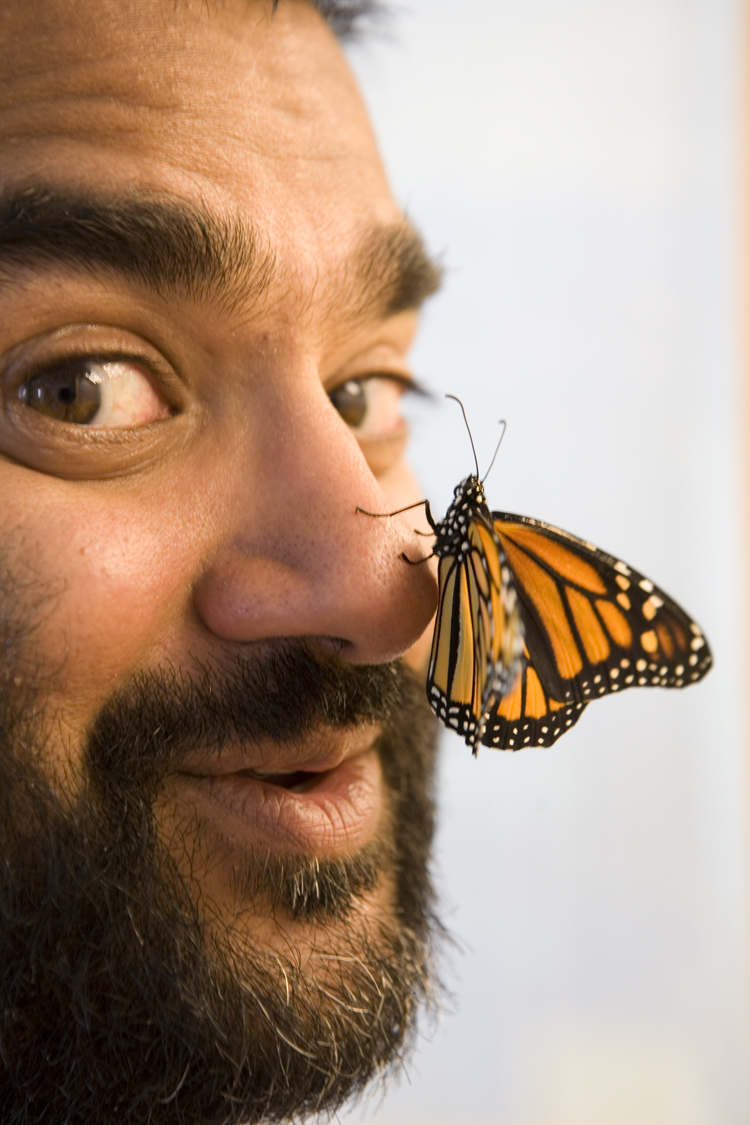
Anurag AGrawal, author, scientist, Monarch butterfly lover. Courtesy photo
Finally, Dr. Anurag Agrawal, conservation biologist at Cornell University and author of the soon-to-be-released Milkweed and Monarchs: A Migrating Butterfly, A Poinsonous Plant, and their Remarkable Story of Coevolution told us that while he is first and foremost a scientist, he sees beauty in biology.
He recalled seeing Monarchs in the fields of Pennsylvania as a child and attributes their magic to their transformative metamorphosis. “Who does that? Going from leaf-eating worm to flying machine. Going from Canada to Mexico. And going from a billion butterflies to too few,” said Agrawal. “Don’t leave us magnificent Monarchs. We need you for inspiration, for study, and to remind us of our place.”
Why do YOU love Monarch butterflies? Leave a comment below to let us know.
Related posts:
- Monarch Butterfly numbers down by 27%, freak sleet storm to blame
- Monarch Butterfly and Pollinator Festival a roaring success
- Monarch migration update: south winds, hot temps stall butterflies on Llano River
- Monarch Butterfly release “better than any church service”
- San Antonio named first Monarch Butterfly Champion city by National Wildlife Federation
- Texas Comptroller awards $500K in Monarch research grants
- Butterfly bonanza: Monarch netted on Llano River tagged in Oklahoma
- How to Tag a Monarch Butterfly in Six Easy Steps
- What does climate change mean for Monarch butterflies?
- New study: late season nectar plantsmore important than milkweed to Monarch migration
- Should You Bring in a Late Season Caterpillar into Your Home?
Like what you’re reading? Follow butterfly and native plant news at the Texas Butterfly Ranch. Sign up for email delivery in the righthand navigation bar of this page, like us on Facebook, or follow us on Twitter, @monikam.

Wonderful article I enjoyed reading.
MikeOn the Pacific Fly way migratory path here in California there was a significant influx in adult butterfly sightings last fall. I also noticed an influx in the amount of host food plants in my hiking trips into the foothills where stands of Purple Milkweed were seen in abundance. I’ve also seen more Mexican Whirled Milkweed in some areas here as well. I found Monarch caterpillars in several instars of development on every field trip I made in July.
It was encouraging to see this amount of activity as in previous years sightings of adult Butterflies and encountering larvae or chrysalids was way less common.